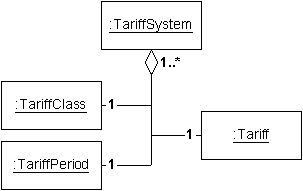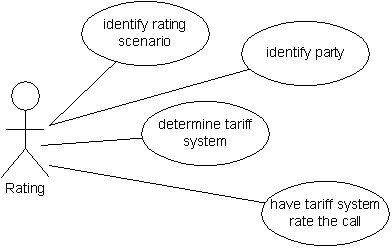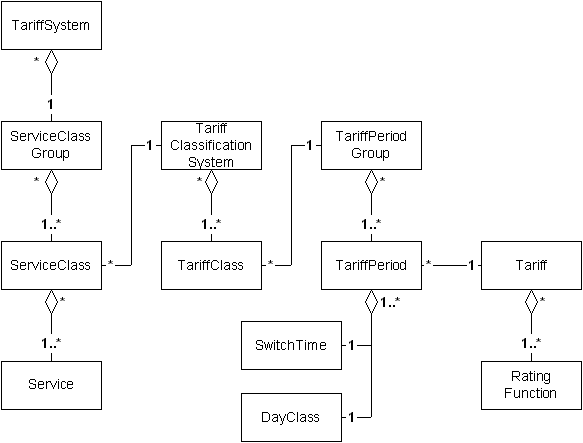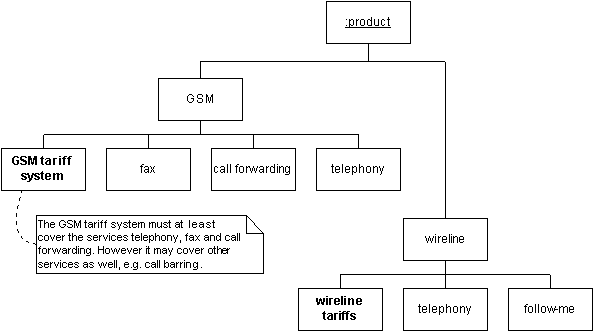
Tariff SystemIn OSB the rating of network usage is separated from the handling of all other charges during billing. OSB uses tariff systems to define usage rates and to support the rating process. The latter handles the usage records streams and identifies the parties involved in a call, while the tariff system is responsible to determine the rate for a particular call and party. |
A simplified model of how a tariff system works is as follows:

Before entering the realm of tariff systems, we should briefly discuss the rating process so that we can understand the role the tariff system plays within the process:

For each usage record Rating performs the following steps:
From the three above steps it should become clear, that the TariffSystem is responsible to determine the usage charges. Otherwise the rating has to identify the parties, validate the network usage by that party and to select the tariff system that should be applied for that party.
Before putting our focus on the classes that are neeed to construct a tariff system lets look at a sample tariff description (extracted from SwissCom's website):
| Natel swiss | |||
| Mobile telephony | Rate | ||
| Calls to Swisscom numbers | 1) | ||
| Normal tariff | 0.59 | ||
| Low tariff | 0.40 | ||
| Night & Weekend tariff | 0.20 | ||
|
Calls to other national operators |
1) | ||
| Normal tariff | 0.79 | ||
| Low tariff | 0.53 | ||
| Night & Weekend tariff | 0.20 | ||
|
Calls to country group 1 |
1) | ||
| 7 days, 24 hours | 0.60 | ||
|
Calls to country group 2 |
1) | ||
| 7 days, 24 hours | 0.80 | ||
|
All other international calls |
1) | ||
| 7 days, 24 hours | 4.00 | ||
| WAP service | 1) | ||
| 7 days, 24 hours | 0.20 | ||
| Short Messages | |||
| incoming | free | ||
| outgoing, per message | 0.20 | ||
|
Swiss Free Call (0800) |
free | ||
|
Business Numbers (08XY...) |
|||
| Operator charge + Surcharge per minute | 0.30 | ||
|
Supplementary services |
|||
| call forwarding, call hold, call wait, call barring, ... | free | ||
1) Rates are per minutes, charged in intervals of 0.10 (partial or complete).
| Tariff times | |
| Normal tariff | Mon - Fri, 07:00 - 19:00 |
| Low tariff | Mon - Fri, 06:00 - 07:00, 19:00 - 22:00 |
| Night & Weekend tariff | all other times incl. public holidays |
Diagram provides an overview of the classes that are used to build up a tariff system. The classes are designed with the following goals in mind:
|
Flexible |
The internal structure of a tariff system must be able to adapt to future requirements. At the beginning of this section I have already introduced the most important design decision to achieve this: A tariff system assigns a tariff to every pair <tariff class, tariff period>. This abstraction allows OSB to rate any network usage for which appropriate classification rules can be defined. |
|
Modular |
A tariff system should consist of building blocks with minimal dependencies amongst each other. This not only eases their construction and validation, but also allows to use the same blocks in several tariff systems. |
|
Reproducible |
Usage charges must not depend from the time at which the calls are actually rated: The calculated usage charges should remain the same, no matter if rating is done immediately after the call or two weeks later. |
|
Adjustable |
Adjustments in the configuration of a building block should be possible without need to change the tariff objects that depend on the changed module. Changing off-peak time, e.g., does not affect how much is charged for an off-peak call; common sense tells us that there shouldn't be a need to release a new version of all tariff systems using peak and off-peak times. |

The discussion of diagram describes the tariff object classes and introduces the construction principle of tariff systems. For this I'm using a top-down approach, i.e. I assume that all building blocks are ready for use. In real life of course we'd first have to create the individual modules before using them for the construction of higher level entities.
Design notes
| 1 |
We have choosen this design to achieve better maintainability: A different approach would be to add each individual service to a service class group and to specify its service class at the same time. This however would require that several service class groups must be changed if a service is added or deleted. |
|
In the moment it not clear yet, how the rating scenario can be used within
the tariff system to determine the tariff that is to be applied. |
This section provides a definition for each class in diagram III:
| class | definition |
| TariffSystem | A tariff system defines the tariff for the network usage. It contains a consistent set of tariff objects. |
| ServiceClassGroup |
A group of ServiceClass. |
| ServiceClass | A group of one or more usage services. |
| Service | A kind of network usage. It describes how a network can be used or how it was used. |
| TariffClassSystem |
A set of TariffClass and a rule (or framework
of rules) that selects exactly one of its TariffClass for a given call. |
| TariffClass |
A call attribute that -together with the TariffPeriod- defines which Tariff is applicable for a given call and ServiceClass. |
| TariffPeriodGroup | A set of TariffPeriod that completely contains the calendar year and defines a TariffPeriod for the complete 24 hour period of every day. |
| TariffPeriod | Describes a part of one calendar day during which the a same Tariff is applied. |
| SwitchTime | Defines the time from which on a Tariff is applied. |
| DayClass | A group of one or more SpecialDate and WeekDay. Within a TariffPeriodGroup a DayClass must be defined for every WeekDay. The DayClass, of the SpecialDate overrules the DayClass of the corresponding WeekDay. |
| SpecialDate | A particular (recurring) date of the year. Only one DayClass may be assigned to a given distinct date. |
| WeekDay | A day of the week: Sun, Mon, …, Sat. |
| Tariff |
A set of RatingFunction that defines the rating of the network usage for a given TariffClass and TariffPeriod. |
| RatingFunction |
A rule how to rate the volume of a call. |
This section describes the tariff class systems that are supported by OSB.
The task of tariff system class is classify the usage records into classes for
which the same tariff period group is used to determine the applicable tariff.
In principle the classification may be based on all available call attributes,
though each type of tariff class system will use a distinct, well defined set.
A tariff class system that supports transmission speed sensitive rating of data
services uses the call attribute Quality of Service Mean Throughput
to select one of the tariff classes low transmission rate, normal
transmission rate and high transmission rate.
| Intentionally I did not provide any values for low, normal
and high transmission rate: A reasonably well designed tariff class system must allow to the user not only to configure the criteria but also define an arbitrary number of tariff classes. |
In technical terms a TariffClassSystem is an abstract base class that defines the following functionality:
The advantage of this abstraction is obvious: OSB can easily be extented to use any call attributes as criteria for rating. It does not matter how complex the rules and configuration for a new type of tariff class system are, as long as the type is able to come out with a TariffClass for a usage record it can be used for the construction of tariff systems.
In order to achieve reproducibility and to insure consistency among the blocks OSB maintains different versions of the tariff system modules.
The live cycle of a tariff system object is show in diagram

| Status changes: allowed transition for TS objects | |
|---|---|
|
+ Reproduction time |
|
| Rule 1 | The status of tariff system object can be decreased only if no tariff objects that depend on the changed object with a status higher than the target status exists. |
| Rule 2 | Try to find a global definition for "depend"! |
For a successful check of a tariff system, the following conditions must be fulfilled.
A tariff period group is consistent if:
For the following tariff system classes multiple versions are supported: TariffSystem, TariffPeriod, TariffPeriodGroup, TariffZoneGroup, TariffZone,
![]() BELOW HERE UNDER CONSTRUCTION
BELOW HERE UNDER CONSTRUCTION
The rating of a call depends on it's TariffClass and TariffPeriod. The TariffClass depends always on the ServiceClass and, for distance and routing sensitive routing, on the TariffZone.
The TariffSystem defines a tariff for every tupel <TariffClass, TariffPeriod>. The TariffClass is a set of ServiceClass or TariffZone.
The ServiceClass of a call is determined by the used service and service specific attributes, e.g. the transmission rate for a data service.
The TariffZone is obtained from the distance and routing relevant call parameters.
The TariffPeriod is reflects the date and time the call was made.
The three classes ServiceClassGroup, TariffZoneGroup and TariffPeriodGroup support the administration and the validation of a tariff system. Each of these classes defines the usage record attributes that are used to classify a call and the classes must ensure that this classification is unique and complete.
| For the network service Telephony sub-service classes exist, e.g. international calls. The subclass can be determined only by evaluating additional call attributes. Tariff classification systems have this capability: We could use the tariff class to subclassify a service. Using this approach would then mean that the product item service must be changed accordingly. |
Before we explain and define each tariff system classes let's take the SwissCom example from above and see how it maps to the OSB definition of a tariff system. The relation is given in the table below:
| Class | Entity names | Comments | ||||||||||
|---|---|---|---|---|---|---|---|---|---|---|---|---|
| TariffSystem | Natel swiss | other tariff systems of SwissCom are: Natel budget, Natel business, ... | ||||||||||
| ServiceClassGroup | GSM services | |||||||||||
| ServiceClass |
|
|
||||||||||
| TariffZoneGroup |
Telephony |
|||||||||||
| TariffZone |
|
|||||||||||
| TariffClass |
For a given network type a tariff system must at least cover all usage services that are available in a product:

The sample product shown in diagram offers GSM and wireline services. For both network types a tariff system must be part of the product.